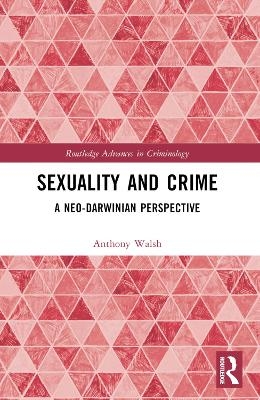
Sexuality and Crime
Routledge (Verlag)
978-1-032-50462-9 (ISBN)
- Lieferbar (Termin unbekannt)
- Versandkostenfrei innerhalb Deutschlands
- Auch auf Rechnung
- Verfügbarkeit in der Filiale vor Ort prüfen
- Artikel merken
Written by one of the leading figures in biosocial criminology and evolutionary psychology, this work explores the tight relationship between criminality and indiscriminate sexuality within the framework of life history theory. The underlying thesis is that traits associated with a strong libido, indiscriminately expressed, are intertwined with traits associated with criminal behavior; that is, excessive interest in sexual adventures pursued in an irresponsible way is undergirded by the same individual short- run hedonistic traits that define criminality. While traditional criminology tends to view sexual and criminal behavior as separate domains, many biosocial criminologists, evolutionary psychologists, neuroscientists, and behavioral and molecular geneticists are not at all surprised that a link exists between criminality and sexuality. Research shows that the statistical relationship between indiscriminate sexuality and criminal behavior is stronger than for most other variables associated with crime, although most studies dealing with this relationship are from outside the dominant environmentalist paradigm of criminology.
Using life history theory as the theoretical umbrella for exploring the relationship between indiscriminate sexuality and criminal behavior, the book explores how and why criminal behavior is related to hypersexuality. Life history theory, which has a long and fruitful history of use among evolutionary biologists who use it to investigate the relationship between mating strategies and the environment among various species of animals (including humans) is particularly suited to understanding how an exclusive focus on mating effort is related to criminal behavior.
This book will be of interest to scholars and students in criminology, psychology, and sociology, and anyone interested in examining the interconnection between biological, psychological, and socio- environmental factors in relation to criminal behavior.
Anthony Walsh is a professor of criminal justice at Boise State University. He has taught biosocial criminology, statistics, and philosophy of law there for 34 years. He received his PhD in criminology from Bowling Green State University in 1983. He worked as a marine, merchant seaman, police officer, and probation officer before entering academia at the age of 44. He is widely published, with 50 books and 150 articles and book chapters on a variety of topics including criminology and biosocial aspects of crime. He was awarded lifetime achievement awards from both the Biosocial Criminology Association and the Biopsychosocial Section of the American Society of Criminology for his research in biosocial criminology. His work has been featured on the Phil Donahue Show, Nova, and Nippon (Japanese) TV.
Chapter One: Bringing Biology Back In
Introduction
Biosocial Criminology
The Fallacy of Genetic Determinism
Behavior and Tinbergen’s Four Questions
Chapter Two: Behavioral Genetics: Genes and Heritability
From Gene to Protein
The Concept of Heritability
Twin and Adoption Studies
Heritability in Different Environments
Shared and Non-Shared Environment
Gene-Environment Interaction and Gene-Environment Correlation
Chapter Three: Molecular Genetics and Behavior
Genetic Polymorphisms
Quantitative Trait Loci
Epigenetics
Dopaminergic Polymorphisms and Criminal and Sexual Behavior
Genetics and Human Freedom
Chapter Four: How Criminal Traits Evolve and Are Retained
Crime is Normal
Altruism
Empathy
Cooperation Creates Niches for Cheats
Detecting and Punishing Cheats
Chapter Five: Evolutionary Theories of Crime
Evolutionary Theories of Crime: Past is Prolog
Cheater and Conditional Adaptation Theories
The Gender Ratio Issue
The Age-Crime Curve
Chapter Six: Life History Theory and the Covariance of Sexual and Criminal Traits
The Basics of Life History Theory
Human Life Histories and the K-Factor
Linking Sexuality to Criminal Traits and Behaviors
The Role of the Environment on Life History Strategies
Chapter Seven: The Human Brain
The Enchanted Loom and Reinforcement Sensitivity Theory
Wiring the Brain: Experience Expected and Experience Dependent Mechanisms
Synaptogenesis as Neural Darwinism
Neurotransmitters
The Serotonergic System
Norepinephrine and Epinephrine
Testosterone and Cortisol
Chapter Eight: The Antisocial Personalities: Psychopaths and Sociopaths
Differentiating Antisocial Personality Disorder, Psychopathy, and Sociopathy
The Psychopathy Checklist-Revised
Evolutionary Considerations
The Neurobiology of Psychopathy
Neurochemistry Associated with Psychopathy
Sociopathy
Chapter Nine: The Sex Ratio, Fast Life Histories, and Crime
The Sex Ratio
Crime and the Sex Ratio
The Sex Ratio in the African American Community
The Sex Ratio, Illegitimacy, and Poverty
High Sex Ratios and Crime
References
| Erscheinungsdatum | 14.04.2023 |
|---|---|
| Reihe/Serie | Routledge Advances in Criminology |
| Zusatzinfo | 2 Tables, black and white; 3 Line drawings, black and white; 3 Illustrations, black and white |
| Verlagsort | London |
| Sprache | englisch |
| Maße | 152 x 229 mm |
| Themenwelt | Sachbuch/Ratgeber ► Natur / Technik ► Natur / Ökologie |
| Geisteswissenschaften ► Psychologie ► Sexualität / Partnerschaft | |
| Naturwissenschaften ► Biologie ► Humanbiologie | |
| Naturwissenschaften ► Biologie ► Zoologie | |
| Recht / Steuern ► Strafrecht ► Kriminologie | |
| ISBN-10 | 1-032-50462-5 / 1032504625 |
| ISBN-13 | 978-1-032-50462-9 / 9781032504629 |
| Zustand | Neuware |
| Informationen gemäß Produktsicherheitsverordnung (GPSR) | |
| Haben Sie eine Frage zum Produkt? |
aus dem Bereich


